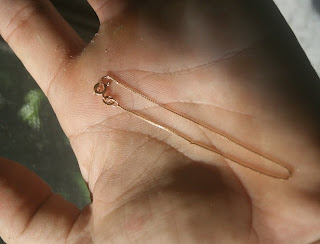 |
| Very Thin Gold Chain Beach Find |
I would venture that most people would miss a chain that thin. The largest part of it is by far the round clasp.
If you are not using a good detector, or are using too much discrimination (any in this case) or are sweeping your coil too fast, you'd probably miss an item like this. Almost anything that is not optimal could cause you to miss something like this.
I'm always pleased to find very small gold, not because it is worth so much, but I know if I am finding the small pieces that I am doing some things right and will get the larger items too.
If you get the smalls, you won't have to worry much about the others.
A few days ago I posted a couple fossil finds by Daniel B. I don't think I told what they were. I needed an expert opinion on one of them and got that opinion from my good online expert Fred D., who came through as usual.
That story got buried by the big gold finds on the Nieves site, but it is time to look at the fossils again.
First, here is a picture like the one I previously posted of Dan's fossils finds.

You might remember that he was finding shark teeth in shell piles when he found these.
I asked what you thought they might be. I got the one of the left correct. It is a tooth plate for a fish such as a drum. Fred D. says it could also possibly be from a sturgeon.
The reason I thought I knew that one is because one of the first fossils that I ever found came up in a scoop full of sand when I was digging jewelry in the water many years ago. I noticed it but didn't know what it was. I kept it and later found out from Richard Hulbert of the Florida Museum of Natural what it was.
One lesson here is that when sending photos for ID, it is often necessary to have good photos taken from multiple angles. I could tell what the first item was from the one angle, but the other item needed to be seen from other angles.
I asked Dan B. to send more photos and he did.
 |
| Additional Photoa of Same Items Finds and Photos by Dan B. |
Do you know what the item on the left in the bottom photo is yet? If you do you know your fossils.
Here is what Fred said it is - half of a cusp of a tapir tooth. Thanks Fred! Isn't it great to have experts to answer your questions. I love it.
 |
| Tapir Teeth in Jaw Section. Photo sent by Fred D. |
Fred didn't say but I would bet the picture above is one of Fred's finds.
Did you know that tapirs were once a part of the Florida fauna?
Here is what a tapir looks like.
 |
| Tapir Photo from National Geographic Web Site Linked Below. |
| It says, On average, a Tapir is around 7 ft. (2M) long, 3ft. (1M) at the shoulder and anywhere between 330-770 lbs. (150-300kg). These robust primitive mammals have changed little in millions of years. This prehistoric mammal is a good swimmer that usually stays close to water to cool itself and avoid predators. |
This “living fossil” had hoofed toes, with 3 toes on the back legs and 4 toes on the front. They have evolved this adaptation over time and it gives them the ability to better walk in silt, clays and overall marshy ground. Appearing in the Early Eocene around 55 Million Years ago, this ice age mammal was a member of the Perissodactyls, or “odd-toed” ungulates.
Here is the link to read more about tapirs.
http://animals.nationalgeographic.com/animals/mammals/tapir/
Two things I would like you to take away form this post is to remember to keep your eyes open while detecting. Look for things like fossils or whatever. Also when sending photos, two or three angles can be very helpful.
Happy hunting,
TreasureGuide@comcast.net
